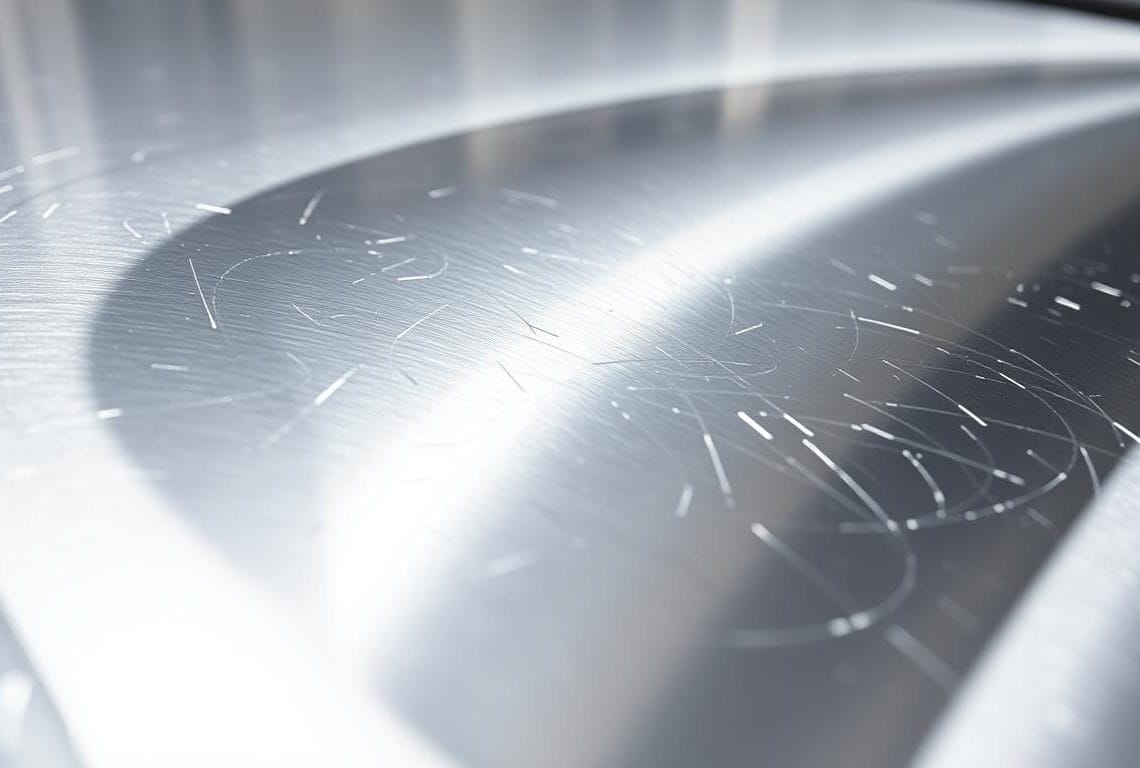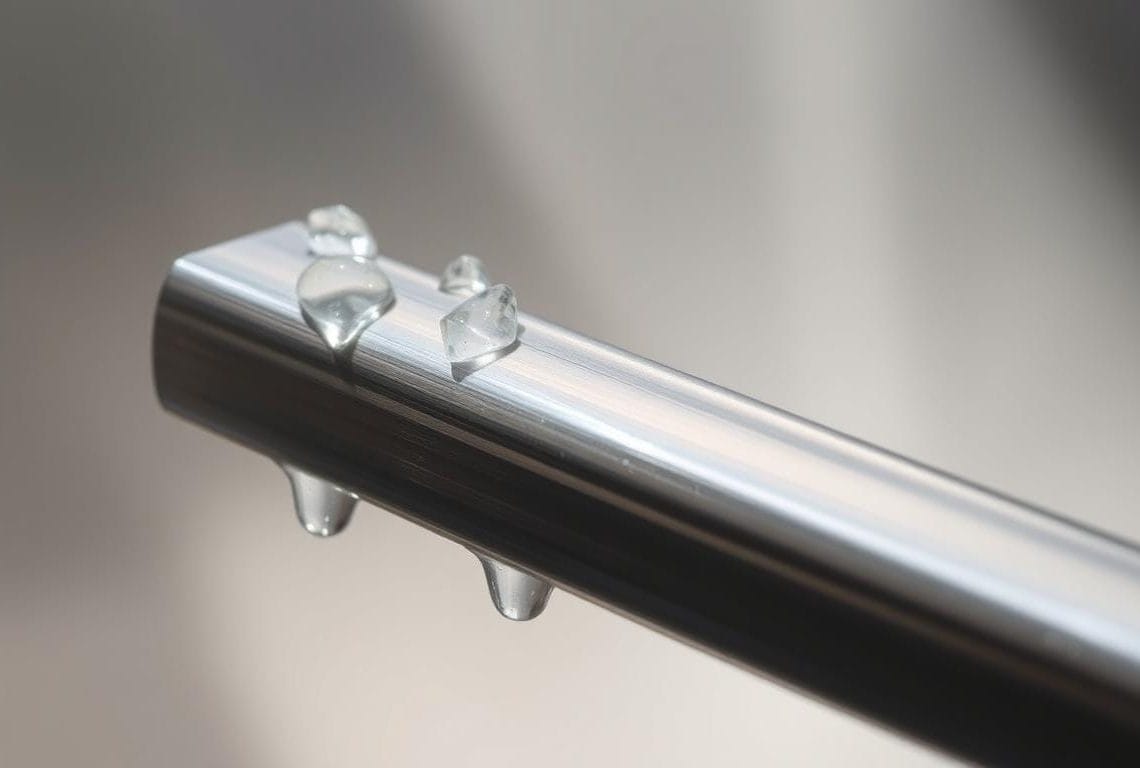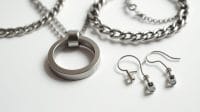Can a modern alloy replace precious metals for daily wear and still look premium? This guide answers that question with clear facts and practical tips.
The article explains why this metal is a smart choice for everyday pieces. It highlights core material properties: at least 10.5% chromium builds a passive film that fights corrosion, while controlled carbon and added elements tune strength and finish.
Readers will learn the real pros: low maintenance, strong durability, hypoallergenic potential, and recyclability. It also previews the downsides—value that won’t rise, possible dents, tricky sizing, and risks from chlorine and poor sourcing.
Short, practical takeaways follow: how grades affect comfort, simple home tests, and cleaning tips. The goal: help homeowners, metal workers, and shoppers decide on the right choice for their style and lifestyle.
Why stainless steel as jewelry is trending in the United States today
Affordable durability is driving a clear shift in what people choose for daily adornment.
Low upkeep and strong corrosion resistance help pieces keep their finish through a busy day. Retailers list thin chains, signet rings, and hoops that match both streetwear and business casual looks.
Hypoallergenic options and recyclable sourcing add two more reasons demand has risen. Buyers who worry about skin reactions find certain grades gentler, while sustainability-minded shoppers like high recovery rates.
- Versatility: finishes—brushed, matte, glossy, engraved—fit many styles without premium cost.
- Practical fashion: resilient pieces suit everyday wear and hold up to active routines.
- Mix-and-match: modern shoppers layer metals for contrast; this material pairs well with gold tones and oxidized looks.
- Retail growth: curated gift sets and entry-level collections bring runway looks to broader audiences.
The combined appeal—cost, care, and contemporary style—helps explain why jewelry trends now favor this category in U.S. stores and online catalogs.
Quick pros and cons at a glance for everyday wear
A clear pros-and-cons snapshot makes it easy to weigh real-world tradeoffs for everyday pieces.

- Durability: Stainless steel resists everyday wear and typical scuffs better than softer metals, so styles stay presentable with little upkeep.
- Appearance: Finishes from glossy to brushed keep a modern look over time without constant polishing.
- Comfort and safety: Certain grades show hypoallergenic potential and biocompatibility, helping sensitive skin tolerate longer wear.
- Low maintenance: A monthly wipe and occasional gentle clean save time and extend the piece’s life.
- Versatility: From a minimal bracelet to a chunky chain, designs match many outfits and style goals.
Cons:
- Investment: Value rarely appreciates—buy for utility and style, not long-term gain.
- Dents and damage: Hard surfaces resist scratches but can dent under force; careful storage reduces risk.
- Resizing limits: Hardness that protects the finish also makes ring and bangle adjustments difficult after purchase.
- Chemical sensitivity: Chlorine and strong cleaners can degrade finishes—remove pieces before swimming or heavy cleaning.
- Nickel caution: Some alloys include nickel; choose reputable sellers and marked grades to lower reaction risk.
In short: for low-effort daily wear, this material offers strong durability and style at modest cost, but buyers should watch for dents, resizing limits, and chemical exposure over time.
The material science: what makes stainless steel jewelry durable
A piece’s lifespan begins at the alloy level—its chemistry sets the limits for strength, finish, and corrosion resistance.

Chromium content (minimum 10.5% by content) reacts with oxygen to form a thin chromium-oxide film. This passive layer self-repairs and shields the metal from moisture and corrosion.
Low carbon—typically ≤1.2%—helps preserve that film at welds and edges. Lower carbon reduces sensitization, keeping corrosion resistance intact over time.
Alloying elements and practical effects
- Nickel (8–10%): stabilizes the austenitic structure for better formability and toughness—useful for clasps and fine links.
- Molybdenum: boosts resistance to chloride attack, which helps pieces survive sweat, pools, and coastal air.
- Balance of properties: hardness, tensile strength, and ductility allow thin, sleek shapes that resist dents and micro-scratches.
Common grades—304 (≈18% chromium, ≈8% nickel) and 316L (low carbon with molybdenum)—explain real-world differences in corrosion performance. For more on benefits and care, read more on practical benefits.
Understanding grades: 304 vs 316L surgical steel in jewelry
Not all alloys are equal—304 and 316L perform differently under real-world conditions. Knowing the grade helps match piece properties to how it will be worn.

What the “L” means and why 316L resists chloride better
The “L” stands for low carbon. That lower carbon content reduces carbide formation at welds and engraved edges.
316L adds molybdenum and tweaks the alloy mix so it resists chloride pitting better. This improves performance against sweat, pool chemicals, and coastal air.
Markings you might see: SS, 304, 316L, S.Steel
Look for stamps on clasps or ring interiors: SS, 304, 316L, or S.Steel. Those marks confirm composition and buyer expectations.
- 304 vs 316L: both austenitic; 316L offers superior chloride resistance.
- Chromium & nickel: chromium builds the passive film; nickel supports the austenitic structure and comfort.
- Shopping tip: pick 316L for high-salt exposure; 304 is a cost-effective baseline for pendants and low-sweat wear.
Real-world durability: scratch resistance, dents, and daily damage
Wear from work and hobbies exposes where a metal’s hardness helps — and where it can fail.

The material offers clear durability benefits: hard surfaces resist micro-abrasions from desk work, pockets, and light tools. That means fewer hairline scratches than softer metals and less need for frequent polishing.
Still, sharp impacts can produce localized dents. The same hardness that guards against scratches also makes refinishing more involved—plan to protect high-contact areas instead of relying on easy rework.
Daily wear concentrates stress at ring edges and bracelet undersides. Simple habits—removing pieces for heavy lifting or when using hand tools—reduce long-term damage and preserve fit.
- Sturdy links resist kinking and elongation under tension.
- Brushed and matte finishes mask minor scuffs better than high-polish.
- Store items separately—pouches or compartments limit knocks and cumulative wear.
- Use gentle cleaning to avoid introducing new swirl marks.
Tip: For active or coastal lifestyles, choose 316L-grade pieces and inspect clasps and links regularly. Overall, this option prioritizes real-world resistance and long wear for everyday pieces.
Corrosion and rust resistance: pool days, sweat, and water exposure
Exposure to pools, sweat, and routine rinses determines how well a piece holds its look over time.

The chromium-based passive layer prevents rust and keeps common pieces bright in normal conditions. In everyday water — rain, handwashing, quick rinses — that film repairs itself and preserves finish.
Chlorine and harsh cleaners — when to remove pieces
Pool days and cleaning chores present a different risk. Chlorine and strong detergents attack finishes and dull luster over repeated exposure. Remove items before swimming, hot tubs, or bleach use.
- For active, warm climates choose higher-alloy grades (316L) for better chloride resistance.
- After any unexpected soak: rinse with fresh water, dry fully, then perform a light cleaning.
- Avoid storing damp items — trapped moisture can undermine the passive film and stain nearby materials.
- Visible orange-brown spots usually signal contamination or chemical damage; address promptly to stop spread.
Simple prevention—remove pieces on heavy-cleaning days, rinse after pool or beach, and dry immediately—extends life and keeps looks intact without special tools.
Skin safety and sensitive skin: hypoallergenic potential and nickel notes
Skin reactions often determine whether a piece works for daily wear more than its finish or price.

Most people tolerate well-made alloys because the passive surface layer limits metal release. Grades like 304 and 316L show low nickel emission and are widely used for body-contact pieces.
When nickel content matters and choosing safer alloys
Nickel sensitivity varies—some users react to low amounts while others do not. If reactions occur with fashion pieces, prioritize 316L or clearly specified 304 and test short wear times first.
- Regulation & labeling: many countries limit nickel release; buy from vendors that state grade and test data.
- Fit and finish: smooth, well-polished surfaces cut friction and reduce irritation for prolonged contact.
- Care tips: clean, dry storage and rinsing after sweat lower the chance of localized rash.
If redness or itching appears, remove the item and try a different grade or a protective barrier. For confirmation and alternatives, consult a jeweler or a dermatologist.
For more details on ear-wear choices and nickel concerns, see stainless steel vs surgical steel earrings.
Aesthetic appeal: shine, finishes, and modern jewelry styles
Finish choices shape how a piece reads — from mirror-bright to tool-soft matte — and dictate daily care needs.

Polished, brushed, matte, and engraved designs
Polished finishes deliver mirror-like shine that resembles silver at a glance. They resist frequent tarnish cycles and suit evening looks.
Brushed and matte textures hide fingerprints and minor scuffs. These finishes create a utilitarian, professional style ideal for everyday wear and active routines.
Engraved designs hold crisp detail because the hard surface preserves edges. Engraving adds personal flair and sharp contrast in minimalist designs.
- Versatility: the base material matches minimal, industrial, and luxe-inspired styles.
- Necklaces and earrings: brushed options feel understated; high polish elevates statement pieces.
- PVD color: black or gold tones expand looks without sacrificing durability.
- Mixing metals: pairing yellow or rose accents with cool tones adds depth to outfits.
Match finish to lifestyle: choose matte for heavy hands-on work and polished for low-abrasion, statement wear. With careful selection, this metal balances contemporary appeal and practical longevity day after day.
Value and cost: affordability versus long-term appreciation
For most wardrobes, the main purchase driver is utility — reliable looks that hold up through regular use and stay affordable.
Over short time, low-cost metals offer clear savings: buyers replace or rotate pieces without major expense. One well-made 316L or 304 item can match the look of pricier alternatives while needing little upkeep.
Consider the purchase choice here: is the goal investment growth, or practical daily wear? Most people choose usability. The market lists many products with solid clasps and chains that resist frequent handling.
- Good value: everyday-ready pieces let owners test trends and build variety.
- Low risk: replacing a lost necklace or bracelet costs far less than replacing precious metal items.
- Flexible styling: pairing a core metal piece with one fine accent yields a premium look for less — try a simple pendant with a mixed-metal accent.
- Shopping clarity: grade and finish explain price more than fluctuating commodity markets; transparency makes buying easier.
In short, treat these purchases as durable style tools rather than financial investments. They deliver reliable appearance retention, easy maintenance, and practical peace of mind for everyday life and travel.
Fit and sizing: challenges with rings, bracelets, and resizing
A proper fit prevents frustration: this alloy’s rigidity makes post-purchase resizing tricky.

Measure carefully before ordering a ring or bracelet — resizing hardened metal later can be complex and costly.
Confirm shop policies on exchanges or reorders. Continuous or engraved bands limit options; open-ended or link-based styles allow future adjustment.
- Practical tip: choose micro-adjustable clasps or removable links for bracelets to avoid cutting and soldering.
- Fit advice: allow a slight comfort gap for seasonal finger changes and wider bands.
- Active wear: aim for snug-but-not-tight to reduce spin and impact marks.
If resizing is unavoidable, expect refinishing work and lead time. Ask the jeweler about exact mm tolerances and potential finish changes.
For more on whether can stainless steel rings be resized, consult a specialist before purchase.
stainless steel as jewelry: a balanced pros and cons analysis
A clear-eyed pros-and-cons view helps buyers match material choice to real life needs. This summary focuses on practical value for everyday wear and quick decisions.

Top advantages summarized for busy shoppers
- Durability and resistance: stands up to daily use with fewer visible scratches and stable finishes.
- Low maintenance: simple cleaning keeps luster—no frequent tarnish cycles like softer metals.
- Comfort and safety: many grades show hypoallergenic, biocompatible behavior for prolonged contact.
- Sustainability: highly recyclable with strong recovery rates for material stewardship.
- Style range: polished, brushed, matte, and engraved options fit minimal to bold looks.
Key drawbacks to weigh before you buy
- Value: buy for function and style—not investment; pieces rarely appreciate.
- Impact marks: dents occur from sharp blows; prevention beats repair.
- Sizing and repair: resizing rings can be difficult; mirror finishes may need specialist work.
- Chemicals and alloys: chlorine and harsh cleaners harm finishes; nickel content varies by grade and seller quality—check markings.
Tip: Buy by grade, match the piece to daily habits, and follow simple care tips. For a clear comparison to precious options, see stainless steel jewelry vs gold.
Care and maintenance: how to clean stainless steel jewelry
A quick, practical cleaning routine keeps pieces bright and helps avoid skin irritation. This section shows two safe methods that fit busy schedules and protect finishes over time.
Soap-and-water method with a soft cloth and gentle brushing
Start with a bowl of warm water and a few drops of mild soap. Soak the piece briefly—no more than a few minutes.
Use a non-abrasive cloth to wipe along the grain. For tight links or settings, a soft-bristled brush removes grime without roughing the surface.
Rinse with clean water and dry fully with a soft cloth. Pro tip: avoid toothpaste, paper towels, or harsh polishing compounds that may mark finishes or damage stones.
Microfiber quick-clean to revive shine without streaks
For day-to-day upkeep, a dry microfiber cloth buffs away fingerprints and light oils in seconds. Rub along the grain to prevent micro-abrasions.
Stubborn spots respond to a lightly dampened pass, then a dry wipe to remove streaks. These simple tips save time and extend the look of the piece.
- Routine: clean monthly under normal use; increase after workouts or humid weather to keep skin contact comfortable.
- After salt or pool exposure: rinse and dry immediately to prevent etching.
- Storage: keep separate cloths and pouches to avoid grit transfer.
Prevention tips: storage, wear habits, and avoiding discoloration
Smart storage and short daily cleans stop minor wear from becoming visible problems.
Keep pieces separate in soft pouches or lined compartments. This prevents rub marks when different metals touch.
Wipe items with a clean cloth at the end of each day to remove sweat and lotion. Monthly cleaning reinforces this habit and preserves the passive surface that resists corrosion.
- Remove rings and bracelets before chores—bleach and strong detergents can harm the protective layer.
- Use silica gel packs in storage to reduce moisture and slow metal changes.
- Travel with rigid cases and dividers; clasp necklaces and lay them flat to avoid kinks.
For active tasks—gym or yard work—minimize wear: grit and sweat accelerate finish wear and trap debris. Rotate favorites to lower cumulative friction on any single piece.
Inspect clasps and joints periodically. Early fixes prevent bigger repairs and help this material keep a fresh look day after day.
How to tell if your piece is real stainless steel
A quick home check helps confirm whether a piece is genuine and fit for daily wear. Use simple steps to build confidence before you buy or care for an item.
Magnet and marking checks you can do at home
First, look for stamps: SS, 304, 316L, or S.Steel on clasps and ring interiors. These marks are common on trustworthy products.
Try a magnet: many austenitic grades show little pull. Strong attraction may mean a different alloy or a plated base metal.
Visual inspection and careful acid test considerations
Wipe the piece with a soft cloth and inspect under bright light. The surface should show a uniform silvery-gray tone and clear grain on brushed finishes.
- Weight and feel: real pieces feel heavier and more rigid than lightweight fashion metal.
- Rust check: orange-brown spots suggest poor coating or contamination, not true resistance.
- Acid caution: a cautious nitric acid spot test can confirm the chromium oxide layer—no reaction usually means authenticity. This is risky; use gloves or consult a pro.
- Nickel claims: verify documentation if you have sensitivities.
When in doubt, combine tests and seek professional verification—XRF analysis at a jeweler gives a definitive reading for alloy content. Use these checks to protect purchase decisions and care plans for your steel jewelry and related products.
Stainless steel vs sterling silver: tarnish, shine, and upkeep
When choosing between bright silver and tougher alloys, maintenance and environment often decide the best fit.
Tarnish: Sterling silver (typically marked 925) will tarnish and needs regular polishing to stay bright. Alloys resist tarnish and keep a consistent look with less effort.
Scratch resistance: Harder metals score higher on the Mohs scale (>5.5 vs silver 2.5–3), so they hold smooth planes and sharp edges longer under daily use.
Shine and water: Both metals can reach high polish; tougher alloys retain that shine longer between care sessions. Everyday contact with water is usually fine, but avoid chlorinated pools to protect finishes.
- Styles: Silver suits warm, vintage looks; modern alloys favor crisp, industrial styles and clean lines.
- Allergies: Some pieces include nickel—grade choice matters. Silver is often nickel-free but can react with sulfur on skin.
- Cost & repairs: Silver has resale value and is easier to resize or refinish. Tougher alloys are more affordable and durable but harder to modify.
Practical decision: Pick by maintenance tolerance, preferred styles, and daily exposure. For mixed looks, pair a silver pendant with a tougher chain in high-contact areas for contrast and longevity.
Style ideas: necklaces, rings, bracelets, and earrings for any day
Balancing weight, finish, and scale makes it easy to build a wearable collection for any day. Pick pieces that serve different functions: one that shines, one that anchors, and one that layers.
Mixing metals with silver and gold to elevate your look
Build a core rotation: two necklaces—one polished chain and one brushed pendant—cover work and weekend needs.
- Earrings: choose brushed huggies for daily comfort; polished hoops or threaders add evening sparkle.
- Rings: stack a slim brushed band with a polished signet to create contrast without bulk.
- Bracelets: mix a flexible link with a structured cuff for balance and movement.
- Design details: small engravings—initials or coordinates—add meaning that wears well.
For active days favor matte or brushed finishes—they hide marks and stay tidy through chores and workouts. Pair a heavier necklace with minimal earrings to keep the overall look easy on the eye.
Travel kit idea: one chain, one pendant, one pair of earrings, and a stackable ring set cover most dress codes and simplify packing.
Smart shopping in the U.S.: grades, product labels, and gift-ready picks
Smart shoppers scan labels first: grade markings and clear care notes separate lasting pieces from disposables.
Read labels: prioritize 316L for active or coastal lifestyles; 304 works for office and low-chloride wear.
Verify stamps on clasps and interior bands—SS, 304, or 316L indicate composition. Reputable products list grade in the description and show care guidance.
- For sensitive skin: check seller claims on nickel release and read buyer reviews for comfort confirmation.
- Finish & construction: prefer solid links, smooth inner edges, and secure clasps—these lasting details matter more than shine.
- Coatings: PVD beats thin plating for color durability and abrasion resistance.
Gift tips: bundle a necklace, ring, or bracelet with a microfiber cloth and a care card. Use free shipping offers to try sizes and styles risk-free, and favor return-friendly sellers.
- Quick checklist: grade, markings, finish, clasp quality, return policy, care instructions.
- Map use to material: choose 316L for gym-goers and travelers; 304 for low-exposure daily wear.
Your takeaway: making the right choice in steel jewelry now
Your takeaway: making the right choice in steel jewelry now
Match grade, finish, and care to get the best mix of durability and daily polish. Choose 316L for heavy sweat, salt, and cleaners; pick 304 for lighter, low-chloride use. This material saves time and delivers steady resistance without frequent fuss.
Protect shine: quick microfiber wipes and occasional soap-and-water cleanings beat harsh fixes. Avoid pool chemicals and prolonged exposure to water to limit rust and surface change.
Verify markings, test short wear for sensitive skin, and build a simple kit — one necklace, one ring, one dress piece. With a trained eye, good habits, and the right grade, pieces keep crisp lines and lasting shine day after day.






